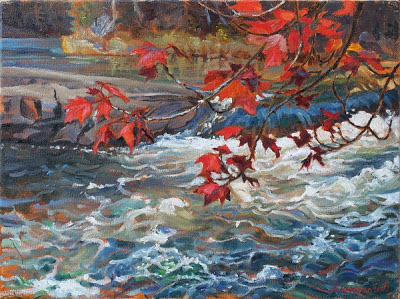Forsythe Road Sunset
 |
| Forsyth Road Sunset (oil on canvas 5 x 8 in.) $275 Sold |
26 December, 2017 found me driving through Limerick Forest, in search of a scene for my annual "Birthday painting". I had started east on Limerick Rd from County Rd 18, just south of Bishops Mills, and turned south onto Cooper Road, and then south on Forsythe Rd, driving slowly and looking into the snowy woods on both sides of the road, through the rolled-down windows. We are in the midst of a lengthy "Polar Vortex" and are grateful for the foot of snow that came to blanket the ground before the deep freeze arrived.
I found my scene after turning around and driving back north past "The Pit" where a mini-van was loading up with rosy-cheeked boys and their sleds, just before sunset. Cresting a low hill, my eyes were met by a familiar sight - the wetland between this morraine and the one where the road takes a "Y", was flooded with late afternoon sunglow. I paused to take photos, with the realization that I would have no time to do more than the underpainting before that golden moment had faded to dusk - so I left it at that, and returned home with reference photos, postponing my "Birthday painting" for another day.
The road, at "The Y" turns NNW to follow the boundary between Augusta and Edwardsburgh townships, while a road-like snowmobile path goes straight north up to the place named "McReynolds", scarcely a settlement anymore. From our northern end, we used to call this road the Limerick [Forest] Access Road, while at the south end in Roebuck it was the [Cheese] Factory Road. In the days of the Limerick Forest Advisory Committee, and the onset of 911 emergency dispatching, it was formally named Forsythe Road after a family which had settled there before agriculture failed on the sandy soil, the land reverted to the Counties for unpaid taxes, and Conifers were planted everywhere that wasn't wetland, under the terms of the Agreement Forests programme.
The trees along the road here are Norway Spruces, while the plantations back from the road, and on the moraine to the north, are Red Pine. These planted trees have grown up to a foot in diameter, and have so sequestered the remaining mineral nutrients from the soil that they make hardly any more growth - in 2006 the argument that the forest needed more nutrients to thrive was the trigger for the dissolution of the Advisory Committee. - http://pinicola.ca/limnutr.htm
Behind the Spruces to the west is a big Beaver flood, and there is brushy swampland to the east. West of the sunlit area in my painting there's a big stand of native Phragmites, golden above the bushes of the swamp - and east of the road approaching the northern moraine there are lots of Ostrich Ferns in the shallow roadside ditch, their hardy fertile fronds now under the snow. When the fiddleheads rise and unfurl in the spring, these dead-looking, club-shaped fronds will open, releasing green spores kept tightly clenched, alive all through the winter.
The wetlands between the moraines don't have big concentrations of calling frogs in the spring - our Wood Frog ponds are north of here http://karstaddailypaintings.blogspot.ca/2010/04/wood-frog-breeding-pond-air.html - but Turtles nest along the road there.



Comments
Post a Comment
What do you think of this painting, and what do you know about the subject that I have painted?